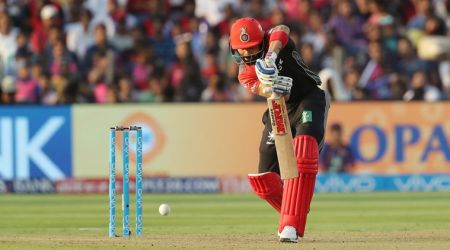 In this picture taken on Tuesday, Cheteshwar Pujara is seen swaying away from a rising delivery. The Indian team didn’t practise on Thursday — Test match eve — with assistant coach Sanjay Bangar insisting it was an optional session and nothing should be read into it. Bangar was addressing the media in lieu of captain Virat Kohli, who in a departure from convention gave the pre-match press conference a miss. (Source: AP)
In this picture taken on Tuesday, Cheteshwar Pujara is seen swaying away from a rising delivery. The Indian team didn’t practise on Thursday — Test match eve — with assistant coach Sanjay Bangar insisting it was an optional session and nothing should be read into it. Bangar was addressing the media in lieu of captain Virat Kohli, who in a departure from convention gave the pre-match press conference a miss. (Source: AP)
There’s a very popular saying in Hindi about camels and mountains. It’s about the illusion of the towering desert ship – so used to be being tallest when walking past the dunes – getting shattered on reaching the lofty peaks.
Watching Virat Kohli and his men train on the foothills of the imposing Table Mountain, on the eve of the Test series against South Africa, brings to mind the camel and doubts about India’s ICC-endorsed tag of the tallest Test team in the world.
After a long march through the grainy brown dunes – India last played a top Test nation away from the sub-continent three years ago – they now find themselves on the unfamiliar green meadows. They look like fish out of water, or rather a camel coming to terms with its Sahara-to-Savannah switch.
Adding to the degree of difficulty is arguably the most complete pace bowling attack in the world. Vernon Philander, Morne Morkel, Kagiso Rabada, Dale Steyn and Chris Morris can make every blade of grass on the pitch count, and at Newlands there have been many.
On match eve, South Africa skipper Faf du Plessis did talk about his dream wicket and how Newlands can come very close to it. “In a perfect world, it will be a quick wicket that nips around a bit. We also want to try and eliminate spin as much as possible. You don’t want excessive seam movement because that brings both bowling attacks into the game. We feel with our seam resources, on a wicket that has some pace and bounce, we can exploit some of those areas in their batting line.”
The Protea plan seemed simple: to flaunt their pace and negate India’s spin strength. Plus there was the extra push that comes when a team is a fighting a common cause, a perceived wrong from the past.
At the back of the minds of this gang of pacers is their team’s trip to India more than two years ago. The back story is important to understand the context of this series. It was in 2015, when South Africa had landed in Mohali with hopes of conquering what Steve Waugh had famously called world cricket’s Final Frontier. They looked odds-on favourites to outdo even Waugh’s Invincibles.
The South Africans weren’t the ever-complaining softies, who carried canned food (Australia) or Fawlty Towers (England) to beat homesickness. After away wins in Australia, England, New Zealand, West Indies and Sri Lanka; they were at India’s doorstep with sleeves folded. They just needed to tick the India box to be the ‘home and away’ world champions.
It was wishful thinking, as Ravichandran Ashwin and Ravindra Jadeja made the all-conquering South African batting greats look out-of-depth, fumbling club players. The diabolical pitches had a role to play in South Africa’s rout. After the first day’s play in the series, opener Dean Elgar had called the Mohali track, prepared by Indian cricket’s grand old curator Daljit Singh, not good for cricket. Later, even the ICC had to step in as pitch police.
South Africa had stepped on a minefield, their streak was broken and the Indian citadel was safe. Interestingly, India was a lowly World No.5 then, the series of away losses reflecting on their ranking. South Africa gave them a U-turn and they never looked back.
Cut to 2018, the wheel has turned. It’s India that is on a hot streak now. They have won nine straight Test series. However, it’s the 10th that’s most important. A loss in South Africa will mean that India will continue to be seen as a backyard bully. Virat Kohli will be praised to the sky when leading his teams to famous wins at home but there will always be the whisper about India’s dismal away record. He will be one of the many illustrious Indian captains who had great records at home but faltered when facing challenging conditions away from home. Kohli has a chance to erase the potential rider at the end of this CV.
For that to happen, India will have to bank on their batting. With opener Shikhar Dhawan fit, the top five pick themselves without much debate. India has three options for the No. 6 spot.
It will be interesting to see who among the three – KL Rahul, Rohit Sharma or Hardik Pandya – gets a chance to make it to the playing XI. It’s one decision that will also give an idea about India’s mindset going into the opening Test of the series.
n In all likelihood, India will go with Rohit Sharma. Of late, the Indian team management has shown blind trust in players enjoying a purple patch. This decision will also have the cushion of the old Indian tradition of playing the opening Test of an important series with an extended batting line-up. It’s always a good idea to have strength in numbers on a green pitch. However, the flip side is Sharma’s away record as a Test player.
Picking Hardik Pandya would be seen as a bold move, something that can be associated with a skipper who wants to be seen as playing new-age aggressive cricket. An all-rounder in the line-up means a less-strong batting line-up but a playing XI more capable of claiming 20 wickets. Picking Pandya conveys India’s keenness to win. The flip side, Pandya abroad, both as bowler and batsmen, is untested. The first Test might be too big a risk to take for this crucial position.
KL Rahul at No.6 was something former South Africa skipper Graeme Smith had advocated while commentating during the Sri Lanka T20 series. He had a strong cricketing logic to his argument. Much more solid than Rohit in Test matches, Rahul at No.6 means a stronger batting line-up and a specialist opener down the order who can face the second new ball. The flip side: It will certainly be an out-of-the-box and ambitious decision. This would mean dropping an in-form Sharma but also presuming that India is sure they will survive the first new ball.
India’s assistant coach Sanjay Bangar didn’t reveal the cards. He spoke about the playing XI being decided on the morning of the match, with the dew at the ground being a factor. “If it’s a bowling-friendly track, then obviously we might go with four bowlers and if the conditions are perceived to be batting-friendly we might opt for five bowlers,” he said.
Du Plessis on Thursday, and coach Ottis Gibson and bowler Vernon Philander before him, have more than hinted that they have plans to blow away the Indian batting. They remember Mohali, they remember the 3-0 loss, they remember how their streak was snapped. Looking at the 22-yards below the Table Mountain, you know the colour of revenge is green.
For all the latest Sports News, download Indian Express App












